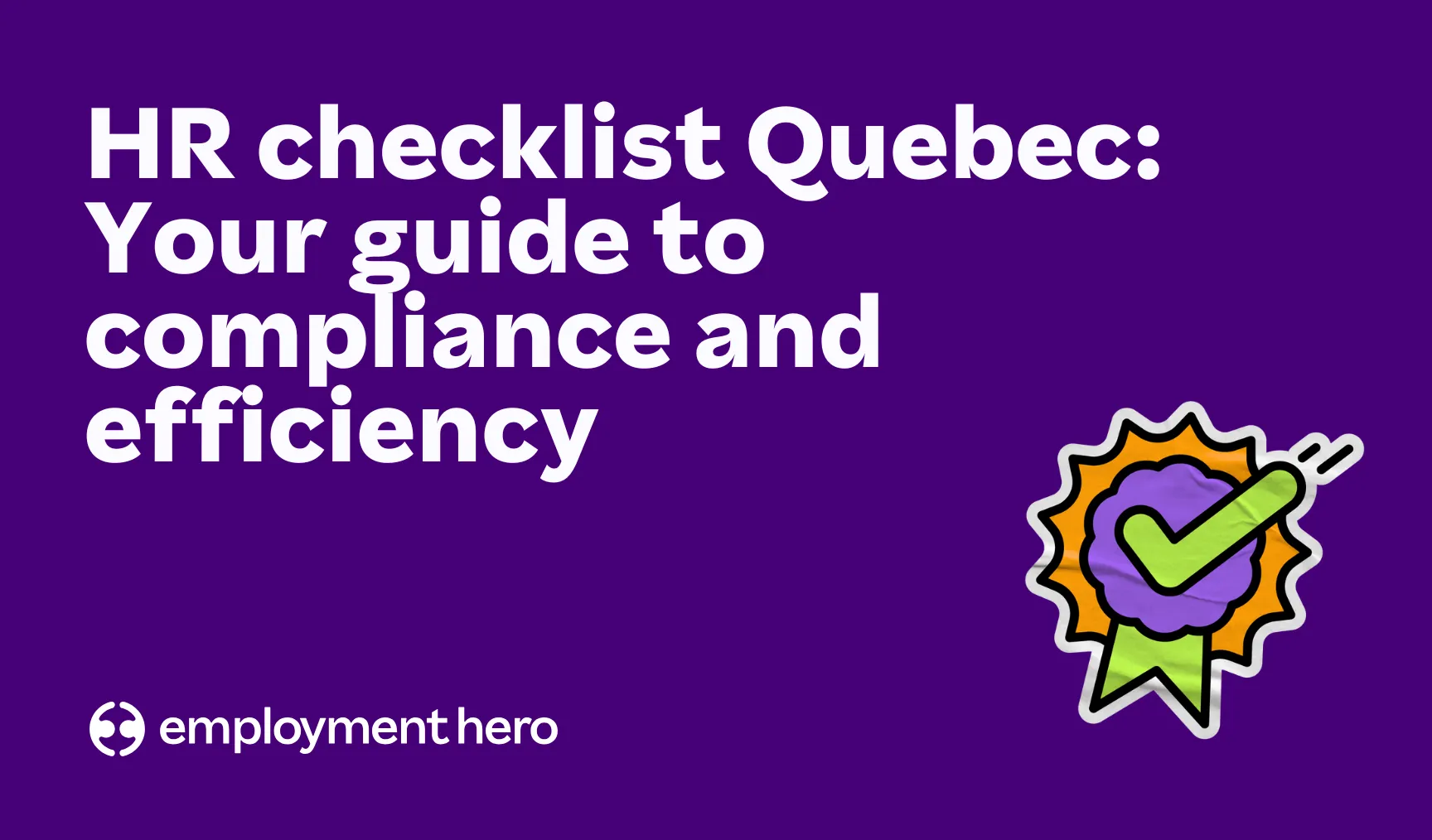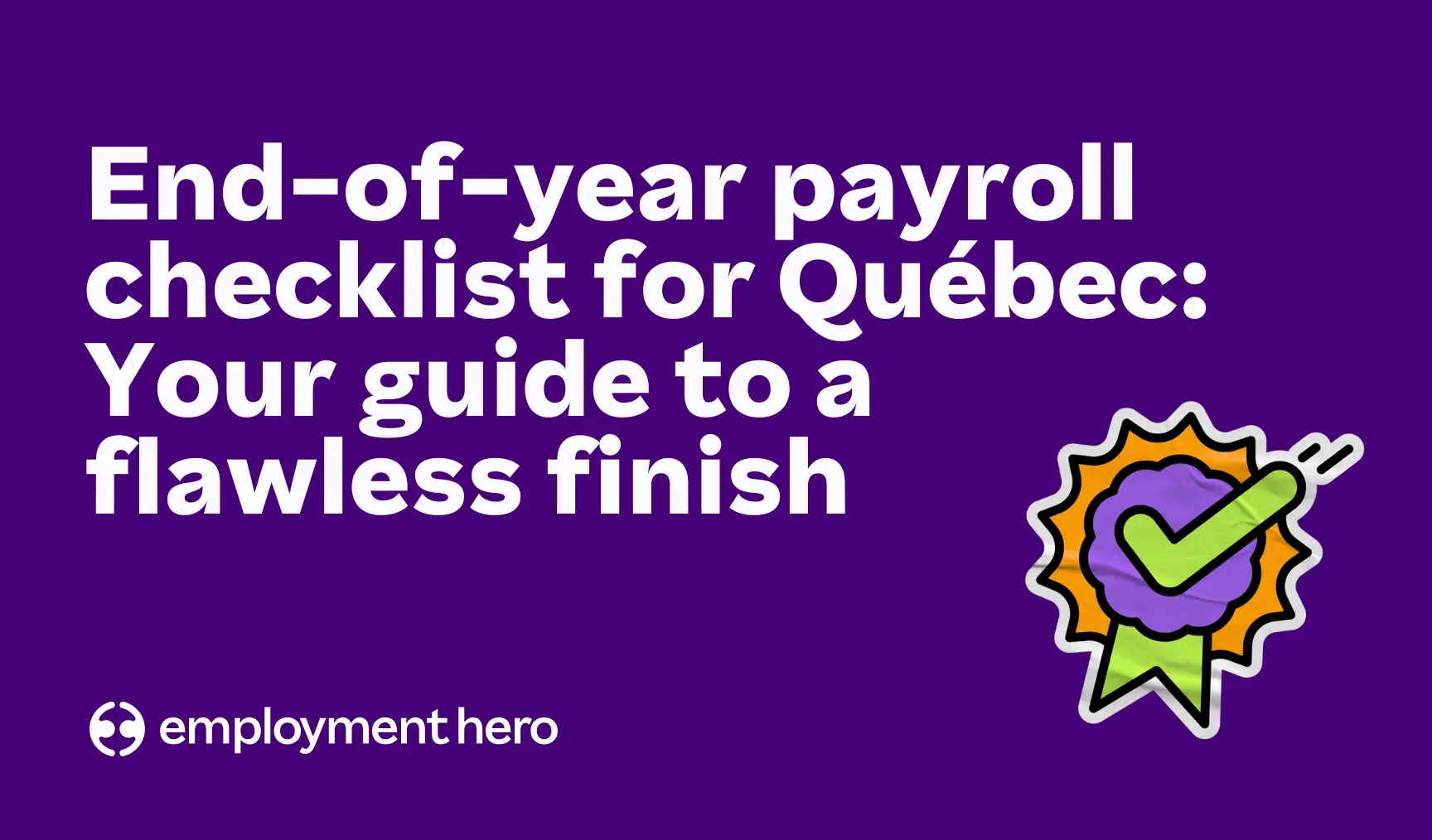Parental leave in Québec: What employers must know
Published
Parental leave in Québec: What employers must know
Last Updated
For your employee, becoming a parent is a life-changing journey. For you, the employer, it’s a critical moment too – navigating complex rules, managing payroll adjustments and ensuring your business thrives while supporting your team members through an exciting time.
When you handle parental leave with confidence and care, it becomes a massive opportunity to build loyalty and show your team you’ve got their back.
This guide is here to make it simple. We’re cutting through the legal jargon to give you a clear playbook for managing parental leave in Québec. Let’s make this a win for everyone.
What is parental leave in Québec for employers?
Let’s get this straight. Parental leave is a distinct, unpaid job-protected leave available to new parents following a birth or adoption. It’s designed to give parents time to care for and bond with their new child.

In Québec, parental leave is surprisingly flexible because it’s three separate, job-protected entitlements that you can stack! Forget the idea of a single leave—you get three different types of protected time off:
| Leave | Who | The timing |
|---|---|---|
| Maternity | Birthing parent | Must be used before or at birth. |
| Paternity | Non-birthing parent | Must start after birth. |
| Parental | Either parent | Flexible, usually follows maternity or paternity leave. |
The key takeaway for employers and new parents alike is that these are separate entitlements. They are unpaid statutory leaves that protect your job while you take time off.
- For the birthing parent: You get to be the master stacker! You will typically take your maternity leave first (to cover the time around the birth), and then seamlessly transition into parental leave for the rest of your time.
- For the non-birthing parent: Your time off starts after the baby arrives. You will most commonly use your paternity leave first, followed immediately by your share of the parental leave.
- Fun fact: While less common, the non-birthing parent can take their Parental Leave before their paternity leave, as long as the paternity leave starts within one year of the child’s birth. This flexibility is possible because each leave is a totally separate, distinct right!
Bottom line for employers: When talking to a new parent in Québec, remember they aren’t just limited to a single block of time. Depending on their role as the birthing or non-birthing parent, they qualify for a generous combination of these distinct leaves. It’s a fantastic system designed to give families the time they truly need!
Parental leave can be taken by one parent or shared between both unlike maternity and paternity leaves, which can’t be shared between parents. Understanding this distinction is the first step to managing the process correctly and supporting your employees as they grow their families.
Now, let’s talk about one of the most common questions: how long can an employee be away?
Length and timing of leave
In Québec, the rules around the duration of parental leave is designed to offer flexibility to parents and an employee is entitled to a continuous leave of up to 65 weeks.
1. In case of birth:
- Beginning: Parental leave may begin the week of the child’s birth.
- End/Maximum length: The maximum length of parental leave is 85 weeks.
2. In case of surrogacy:
- Beginning: Parental leave may begin no earlier than the week:
- the child is entrusted to the person who will become their parent, OR
- the person leaves work to travel outside Québec for the child to be entrusted to them.
- End: The leave ends no later than 85 weeks after the week the child was entrusted to the parent.
3. In case of adoption:
- Beginning: The leave may begin no earlier than the week in which:
- The child is entrusted to their adoptive parents, OR
- The parents leave work to travel outside Québec to pick up their child.
- End: Parental leave ends no later than 85 weeks after the week the child was entrusted to the parent.

Eligibility and notification requirements
So, who gets to take this time off? Not everyone is eligible for parental leave right away. To qualify, they need to be an active employee when they request the leave.
To be eligible for Québec Parental Insurance Plan (QPIP), the employee must:
| Criteria | Details for salaried workers |
|---|---|
| 1. Residency | You must be a resident of Québec on the start date of your benefit period. |
| 2. Insurable income | You must have at least $2,000 in insurable income during the qualifying period (generally the 52 weeks prior to the start of your benefit period). This income comes from employment and includes wages, vacation pay, bonuses, etc. |
| 3. Paid premiums | You must have paid or owe a QPIP premium during the qualifying period. (As an employee, your employer withholds this from your pay and remits it on your behalf.) |
| 4. Work stoppage/reduction | You must have either stopped working or had your usual weekly salary/employment income reduced by at least 40%. The benefit period begins on the day this reduction occurs. |
Here’s the deal on giving notice: your employee must give you at least three weeks’ written notice before they plan to start their leave. This heads-up should include their expected start date and when they think they’ll be back. Life happens, we get it, but this notice period is designed to give you enough time to plan for their absence.
The same rule applies if they decide to come back early. They need to give you at least three weeks’ notice.
Once an employee is on leave, your job isn’t done. You still have responsibilities to them.
Employer obligations during parental leave
Just because an employee is on leave doesn’t mean your relationship is on pause. You have ongoing responsibilities. During an employee’s parental leave, you must continue to handle their benefits as you normally would. This means if you pay a portion of their insurance premiums (like health or dental), you must continue to do so, provided the employee pays their portion.
Their pension plan contributions also continue, with both you and the employee paying your respective shares. In short, the leave should not negatively impact their participation in benefit plans. It’s about ensuring fair and continuous treatment, even when they aren’t actively working.
This duty of fairness extends to the most critical part of the process: their return to work.
Reinstatement and position rights
This is non-negotiable. When an employee returns from parental leave, they must be reinstated to their original position with the same pay, benefits and responsibilities they had before they left.
If their role was eliminated during their leave due to organizational changes, you must offer them an equivalent position. This new role must have comparable duties, wages and benefits. The principle is simple: an employee cannot be penalized for taking parental leave. Their career should be waiting for them, right where they left it.
Sometimes, a full-time return isn’t what’s best for the employee, which opens up other compliant possibilities.
Accommodation of part-time or intermittent return
The return to work can be a significant adjustment for a new parent. To ease this transition, you and your employee can agree to a phased or flexible return. This might look like a part-time schedule for a few weeks or an intermittent leave arrangement.
While you are not legally obligated to grant every request for a flexible return, doing so can be a powerful way to support your employee and retain valuable talent. We know that coming back after parental leave is a huge shift for new parents. To make sure your custom plan—whether it’s a flexible schedule or an intermittent pause—is rock-solid, it needs to be mutually agreed upon in writing. Consider that document your joint commitment. It’s more than just a paper trail; it’s a fantastic, tangible way to show that you are fully invested in your employee for the long haul.
Beyond the logistics of their role, you need to manage the financial side of the leave.
Payroll, salary and overhead cost implications for employers
Parental leave directly impacts your payroll and overhead costs so planning is key. While the employee is on leave, their regular salary is removed from your active payroll. However, you’ll need to budget for other costs.
These include the continuation of your portion of their benefits premiums and any costs associated with hiring temporary staff to cover their duties. Accurately forecasting these expenses is crucial for maintaining your budget and ensuring smooth operations during their absence.
Let’s dive deeper into the specifics of pay and benefits.
Salary continuation, benefits and employer cost
In Québec, you are not required to pay an employee’s salary while they are on parental leave. Their income is covered by the Québec Parental Insurance Plan (QPIP), which is funded by contributions from employees, employers and the self-employed.
Your primary cost is maintaining your share of their benefits contributions, as mentioned earlier. The other major cost is operational: hiring and training a replacement. Factoring this into your annual budget is a smart move that prevents unexpected financial strain.
This brings us to the system that makes it all possible: QPIP.
Contributions and insurance: QPIP connection
The Québec Parental Insurance Plan is at the heart of parental leave in the province. As an employer, you are required to deduct QPIP premiums from your employees’ insurable earnings and contribute your own employer share.
These contributions are remitted to Revenu Québec along with other source deductions like income tax, QPP and EI. It is critical that your payroll system is correctly configured to calculate and deduct these premiums on every pay run. Getting this right is essential for compliance and for ensuring your employees are eligible to receive their benefits when they need them.
Managing these moving parts is much easier with a clear strategy.
Best practices for employers managing parental leave
Don’t just react to leave requests; manage them proactively. A thoughtful approach reduces stress for everyone and reinforces your reputation as a great place to work. This means creating a clear policy and integrating it into your daily operations.
Developing your leave policy
A written parental leave policy is your best friend. It eliminates confusion and ensures everyone is treated consistently and fairly. Your policy should clearly outline:
- Eligibility: Who qualifies for leave.
- Duration and timing: How much time can be taken and when.
- Notification: The process for requesting leave and communicating return dates.
- Coverage plan: How the employee’s work will be managed during their absence.
- Return-to-work process: The steps for a smooth transition back to the team.
A clear policy turns uncertainty into a predictable, manageable process.
Integration with HR systems and payroll workflows
Your systems should do the heavy lifting. Configure your HR and payroll software to track leave dates, manage benefits continuation and handle QPIP deductions accurately. Automating these tasks reduces the risk of human error, ensures compliance and frees you up to focus on supporting your employee. A well-integrated system means you can manage leave start dates, premium payments and eventual reinstatement without missing a beat.
Employment Hero automates QPIP deductions, leave tracking as well as benefits management so you can rest assured about the accuracy and compliance of your employee data. With your integrated payroll and HR, Employment Hero takes the stress out of leave management so you can support your employees when they need it the most.
Ready to explore how we can supercharge leave management for your business?
To download the guide, we just need a few quick details.
Related Resources
-
 Read more: HR checklist Québec: Your guide to compliance and efficiency
Read more: HR checklist Québec: Your guide to compliance and efficiencyHR checklist Québec: Your guide to compliance and efficiency
Ensure compliance with Québec HR policies. Use our comprehensive checklist to streamline hiring, onboarding, benefits and more.
-
 Read more: What every employer needs to know about CNESST in Québec
Read more: What every employer needs to know about CNESST in QuébecWhat every employer needs to know about CNESST in Québec
Learn what CNESST is, your obligations for payroll, workplace safety, pay equity and how to control overhead costs under current…
-
 Read more: End-of-year payroll checklist Québec: Your guide to a flawless finish
Read more: End-of-year payroll checklist Québec: Your guide to a flawless finishEnd-of-year payroll checklist Québec: Your guide to a flawless finish
Simplify your year-end payroll process in Québec. Use our comprehensive checklist to understand your business requirements.












